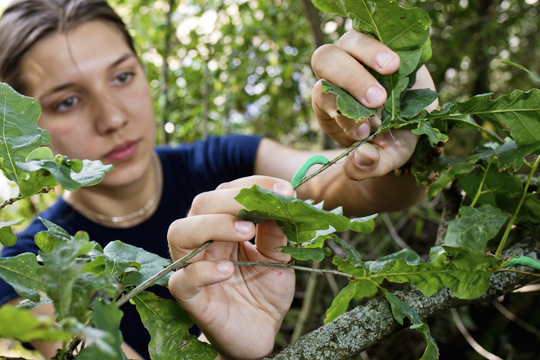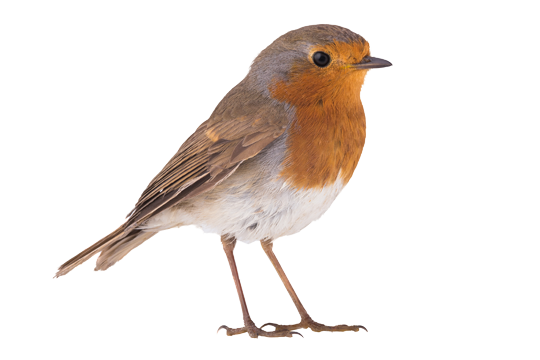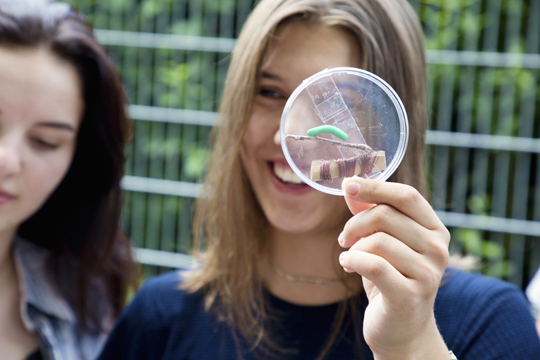Nature’s traces
Freiburg, Sep 10, 2018
How do herbivorous animals and their predators behave? 400 pupils from all over Europe examined their behavior in a Citizen Science project, including an eleventh grade class from the Montessori center ANGELL in Freiburg. To find out more about robins, ants and lizards, the students hid clay caterpillars in oaks and analyzed the traces that animals left behind. A visit to a tree in Freiburg’s Rieselfeld.

With a twist: Dorothea Schiesser attaches the caterpillar to a branch. Photo: Jürgen Gocke
Annette Schuck and her biology class chose the tree a while ago. The group from the Montessori center ANGELL in Freiburg looks up to the crown of a young oak that stands on a paved dirt road in Rieselfeld between ivy and scrub. The eleventh graders are satisfied with their choice. Leyla Strub digs a red metal box from her bag and sits cross-legged on the dirt road. Her classmates unfold a ladder and adjust it on the uneven floor.
“Is this right?” Leyla takes a small green clay sausage from the tin and rubs it between her index finger and thumb. “Sebastian, give her the documents. There are pictures about how the caterpillars should look,” says their teacher Schuck. The students are both excited and serious about their experiment on this Friday afternoon. Everything has to be right when they collect their data. That’s the way it is in science. The young people are among 400 pupils in eight European countries who are collecting data for a project on so-called grazing pressure in oak trees.
Reading traces like researchers
How do herbivorous animals and their predators interact with one another? To find out, the students attach clay caterpillars to the branches. Two and four weeks after they have assembled the fake insects to the oak, they will return there and examine the result. Have birds pecked the dough because they were hoping for real, edible caterpillars? Or have insects drilled their trophi into the mass?

The traces left in the clay give information about how many and which animals have hung out on the tree. For example, robins hoping for an edible caterpillar. Photos: fotomaster/Fotolia
The traces left in the clay provide information about how many and which animals have hung out on the tree, which depends on climate conditions. Researchers will use the results of the school classes to find out the regional differences in insect feeding, predator attacks and chemical defenses that the oaks use against them.
"The clay caterpillars are not just a gimmick developed for schools. The method is actually used in science,” explains Prof. Dr. Michael Scherer-Lorenzen from the University of Freiburg. “The approach is suitable for measuring activities of animals that you cannot constantly observe.” A colleague in France came up with the idea for the project, and geo-botanist Scherer-Lorenzen was so convinced that he brought several schools in the regions surrounding Freiburg on board. “Students learn how to collect data using a standardized protocol. The classes have to work comprehensibly and accurately so that the results have scientific value.”
App instead of measuring tape
But before the Freiburg students can announce their initial results, they have to struggle with a few difficulties at the start. Someone left the measuring tape in the classroom with which the students wanted to measure the circumference of the tree trunk. Sebastian Walker knows how to help. He downloads an app on his mobile phone with which one can measure. “You should not do a sloppy job when measuring because scientists work with great accuracy,” warns Schuck.
Sebastian takes one of the cable ties the class has brought. They are used to mark the branches on which the pupils have attached caterpillars, four pieces each on five branches in total. Using his cell phone, Sebastian determines the length of the cable tie and then walks with it around the tree one time.
 The students received detailed instructions from the research team on how to place the caterpillars on the tree. Photo: Jürgen Gocke
The students received detailed instructions from the research team on how to place the caterpillars on the tree. Photo: Jürgen Gocke
Storm clouds accumulate over the adjacent wheat fields. The air is frozen. A mosquito swarm prances over the heads of the students. Dorothea Schiesser has grabbed the folder with the instructions for the exact procedure and starts. “Do they have to be small or big branches?” The group members shrug their shoulders. Dorothea climbs onto the ladder, bends down a branch and twirls the wire to which the caterpillar sticks. “I'm such a researcher!” she says and laughs. She is satisfied with her first scientific act, pulls out her cell phone and quickly makes a selfie of herself and the oak.
Reliable results through field research
The bite marks will be counted and photographed by the students for the first time two weeks later. Their data will then be entered in a form. Before they send it to a doctoral student in France who will evaluate the results, they will try their hand at their own analysis. Based on the tracks, they should determine which animals attacked their caterpillars, and then consider how the data can be visualized.
“Many people think that science only works with huge machines and expensive equipment,” says Scherer-Lorenzen. He wants to counter this prejudicial view with the project and to teach the students that field research also provides reliable results. “It's a nice experience for the students to work on a project as part of a group 400 strong from across Europe.”
Sonja Seidel

